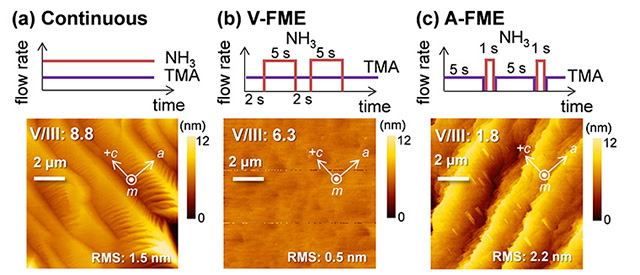Surface Morphology Control of Nonpolar m-plane AlN Homoepitaxial Layers by Flow-rate Modulation Epitaxy
AlGaN is an attractive material for light-emitting devices in the deep ultraviolet spectral region. Particularly, nonpolar AlGaN-based heterostructures can improve internal quantum efficiency and light extraction efficiency compared to the conventional c-plane devices [1]. However, it is difficult to obtain m-plane AlN and AlGaN with a flat surface, although high-quality m-plane AlN bulk substrates have become available. It has been reported that a high growth temperature is required for promoting adatom migration to achieve smooth a surface of the m-plane AlN homoepitaxial layers [2]. On the other hand, flow-rate modulation epitaxy (FME) can also promote adatom migration by modulating the amount of source gas [3]. In this study, we investigated the surface morphologies of nonpolar m-plane AlN homoepitaxial layers grown by the FME technique.
The samples were grown by metalorganic chemical vapor deposition with trimethylaluminum (TMA) and ammonia (NH3). We employed four types of source supply sequences: continuous supply, group-III-source FME (III-FME), group-V-source FME (V-FME), and FME with groups III and V alternated (A-FME).
Figure 1 shows the source supply sequences and corresponding atomic force microscopy (AFM) images of the m-plane AlN homoepitaxial layers grown by (a) continuous supply, (b) V-FME, and (c) A-FME. The flow rates of TMA and NH3 were unchanged, but the average
V/III ratios differed depending on the source supply sequences. We found that a-steps tend to appear when the average V/III ratio is large [Fig. 1(a)], whereas +c-steps tend to appear when it is small [Fig. 1(c)]. This is probably because the a- and +c-steps have different dangling bonds and because the average V/III ratio affects the anisotropic step-flow velocity in a- and +c-directions, which determines step direction. Atomically flat surfaces can be obtained by choosing appropriate growth conditions [Fig. 1(b)]. In addition, +c-steps tend to bunch under the V-FME or A-FME with N-poor conditions. This is probably due to enhanced adatom migration in the absence of the NH3 flow. Thus, we can control the surface morphologies of m-plane AlN homoepitaxial layers by using the FME technique.
This work was supported by JSPS KAKENHI JP25246022.
- [1] R. Banal et al., Appl. Phys. Lett. 105, 053104 (2014).
- [2] I. Bryan et al., J. Appl. Phys. 116, 133517 (2014).
- [3] T. Akasaka et al., Appl. Phys. Lett. 90, 121919 (2007).
 |
| Fig. 1. Source supply sequences and 10×10 μm2 AFM images of m-plane AlN homoepitaxial layers. (a) Continuous (average V/III: 8.8). (b) V-FME (average V/III: 6.3). (c) A-FME (average V/III: 1.8). |